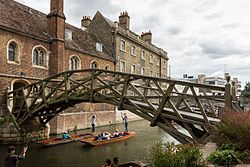Mathematical bridge | |
|---|---|
 Mathematical Bridge at the University of Cambridge in 2016 | |
| Coordinates | 52°12′08.0″N 0°06′54.2″E / 52.202222°N 0.115056°E |
| Crosses | River Cam |
| Locale | Queens' College, Cambridge |
| Official name | Queens' Bridge, Wooden Bridge |
| Preceded by | Silver Street Bridge |
| Followed by | King's College Bridge |
| Characteristics | |
| Design | Truss bridge |
| Material | Wood, on stone abutments. |
| No. of spans | One |
| History | |
| Designer | William Etheridge |
| Construction end | 1906[1] (Current bridge) |
| Location | |
 | |
The Mathematical Bridge is a wooden footbridge in the southwest of central Cambridge, England. It bridges the River Cam about one hundred feet northwest of Silver Street Bridge and connects two parts of Queens' College. Its official name is simply the Wooden Bridge[2] or Queens' Bridge.[3] It is a Grade II listed building.[1]
The bridge was designed by William Etheridge, and built by James Essex in 1749. It has been rebuilt on two occasions, in 1866 and in 1905, but has kept the same overall design. Although it appears to be an arch, it is composed entirely of straight timbers[4] built to an unusually sophisticated engineering design, hence the name.
A replica of the bridge was built in 1923 near the Iffley Lock in Oxford.[5]
The original Mathematical Bridge was another bridge of the same design, also commissioned by James Essex, crossing the Cam between Trinity and Trinity Hall colleges, where Garret Hostel Bridge now stands.
- ^ a b Historic England. "QUEENS' COLLEGE, MATHEMATICAL BRIDGE (Grade II) (1125515)". National Heritage List for England. Retrieved 5 December 2015.
- ^ "TL4458 : Mathematical Bridge, Queens' College". Geograph Britain and Ireland. 2 September 2007. Retrieved 2 November 2012.
- ^ Ordnance Survey. OS Maps Online (Map). 1:25,000. Leisure. Retrieved 8 January 2021.
- ^ "Mathematical Bridge, Cambridge". Engineering Timelines. 2 September 2007. Retrieved 2 November 2012.
- ^ "Iffley Lock". Where the Thames Smooth Waters Glide. Archived from the original on 12 August 2014. Retrieved 13 October 2014.